Seven types of asexual reproduction
Types of asexual reproduction
◆introduction :- in this topic we know about common types of asexual reproduction. Asexual Reproduction found in protozoan protista, fungi ,algae some plants and even some animal. There is several process of Asexual Reproduction like fission, budding, fragmentation, regeneration and spore formation.
Table of Contents
Seven types of asexual reproduction
The small animal which cannot mate with male organism have a benefit to reproduce by Asexual mode of reproduction and producing number of young ones without any cost and time expanding this is major advantage of Asexual mode of reproduction. We know that identical twins are produced in asexual reproduction which have major disadvantage of absent of genetic variation.
definition of asexual reproduction:-
Mode of reproduction in which there is no formation and fusion of gametes and young ones which produce are identical and represent the exact copies of their parents is known as asexual reproduction. Asexual reproduction is also known as apomixis which is the formation of new individual by Asexual Reproduction without involving the formation and fusion of gametes.
what is definition of clone
Morphological and genetical similar individuals which are produced by Asexual mode of reproduction is known as clone.
what do you mean by blastogenesis and blastos
Development of different organisms from non -sexual reproductive units like fragments, buds, gemmules and spore is known as blastogenesis and asexual reproductive body is known as blastos.
◆you should also visits our website https://biologysir.com and other website for civil engineer calculation at civilsir.com
■ follow on YouTube
characteristics of asexual reproduction
1) asexual reproduction does not involves formation and fusion of gametes
2) in asexual reproduction only one parents is get involves so it is called uniparental reproduction
3) in asexual reproduction only mitotic cell division is found in somatic cells of their body
4) in Asexual mode of reproduction new organisms are produced from somatic part of parental body so it is also known as somatogenic reproduction
5) clones which are produced by Asexual mode of reproduction have morphological and genetical identical to their parents so no produce variation and it has no role in evolution
6) it is Rapid mode of reproduction so it is more premitive mode of reproduction than sexual reproduction
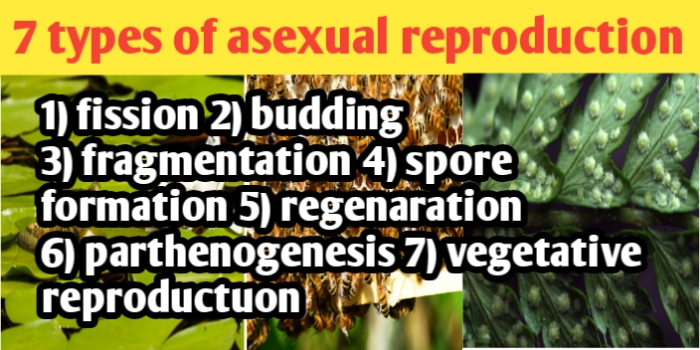
Seven types of asexual reproduction
Types of asexual reproduction
1) Fission
2) Budding
3) fragmentation
4) spore formation
5) regeneration
6) parthenogenesis
7) vegetative reproduction
fission Asexual mode of reproduction
that type of Asexual mode of reproduction in which one parental body of organism divides into two or more daughter cells is known as fission. In the fission process whole parental body is reproductive unit.
On the basis of number of daughter cells produce fission is divided into two types
A) binary fission
B) Multiple Fission
binary fission in bacteria
during the favourable condition of environment adult parental body get divide into two equal daughter cells is known as binary fission. This is the simplest and most common method of Asexual Reproduction found in protist (amoeba euglena), bacteria ,green algae (chlamydomonas) and Planarian (flatworm). In binary fission the karyokinesis that is division of nucleus is followed by cytokinesis that is division of cytoplasm so nothing is left with the parents ,daughter cells feed grow and repeat the process that’s why organism which are undergoing binary fission are also known as immortal.
Types of binary fission on the basis of plane of cytokinesis
a) irregular binary fission
b) longitudinal binary fission
c) transverse binary fission
irregular binary fission
in this mode of binary fission process of cytokinesis take place along any plane but its plane is always perpendicular to that of karyokinesis , for example it is found in amoeba
longitudinal binary fission
in this mode of binary fission cytokinesis takes place along longitudinal Axis for example in euglena
transverse binary fission
in this mode of binary fission cytokinesis takes place along transverse axis for example Paramecium
Multiple Fission in amoeba
that type of Asexual mode of reproduction in which the parental body divide into many daughter cells during unfavourable condition, by the formation of triple layer of cyst wall. During Multiple Fission the nucleus of parents body divide repeated by amitosis into many nuclei. Multiple Fission is found in number of organism like plasmodium and amoeba
budding Asexual mode of reproduction
that type of Asexual mode of reproduction in which one or more unicellular multicellular outgrowths called as buds are formed on or inside the parents body, each multicellular our growth bud enlarge develop the parental characters and separated from parents body grow and develop into new adult organism by the process of budding, budding is found in a sponge, hydra and unicellular fungi yeast .
In hydra and Scypha the buding is external type in which bud is formed on the outer surface of parental body that is known as external bud.but in spongilla freshwater sponge buding process is internal and number of buds known as gemmules are formed inside the parents body.
fragmentation Asexual mode of reproduction
that type of Asexual mode of reproduction in which parental body breaks into two or more fragments, and each body fragments are capable of develop into new organism. This mode of reproduction are found in flat worms, sea anemone hydra and echinoderm.
Asexual reproduction spore formation
members of kingdom fungi and algae reproduce through special Asexual reproductive structure known as zoospores ,
zoospores are flagellated motiles naked protoplasmic body. Formation of zoospores found in ulothrix. And in non motile spore that is known as conodia are found in Penicillium notatum
Asexual reproduction regeneration
that type of asexual reproduction in which organism renewal Restoration growth of several lost part of body like cells tissue and organs, regeneration process is found in planaria
Asexual reproduction parthenogenesis
parthenogenesis is mode of asexual reproduction in which development of an unfertilized ovum into fully formed haploid organisms. This mode of reproduction is found in number of invertebrates aphids and honey bees and some vertebrates like Turkey and some Birds.
There is two types of parthenogenesis one is natural parthenogenesis and second one is artificial parthenogenesis
vegetative reproduction
it is also Asexual mode of reproduction ine which fragments of plant body like roots stem leaf develop into plant, vegetative reproduction is also known as vegetative propagation
Multiple choice questions
1) irregular binary fission found in which of one of following
A) Euglena
B) Paramecium
C) Amoeba
D) plasmodium
Ans. C
2) longitudinal binary fission is found in which one of following
A) Euglena
B) Paramecium
C) Amoeba
D) plasmodium
Ans. A
3) transverse binary fission is found in which one of the following
A) Euglena
B) Paramecium
C) Amoeba
D) plasmodium
Ans. B
4) multiple binary fission is found in which one of the following
A) Euglena
B) Paramecium
C) hydra
D) plasmodium
Ans. D
5) external budding formation is found in which one of the following
A) Euglena
B) Paramecium
C) hydra
D) plasmodium
Ans. C
6) formation of internal Bud is found in which one of the following
A) Euglena
B) Paramecium
C) hydra
D) spongilla
Ans. D
7) which one of the unicellular fungi is reproduce by budding process
A) yeast
B) Paramecium
C) hydra
D) plasmodium
Ans. A
8) apomixis is also known as which one of following
A) vegetative reproduction
B) asexual reproduction
C) sexual reproduction
D) none
Ans. B
9) individuals produce by asexual mode of reproduction is known as which one of the following
A) offspring
B) clone
C) blastos
D) none
Ans. B
10) regeneration process is found in which one of the following
A) Euglena
B) Paramecium
C) hydra
D) planarian
Ans. D

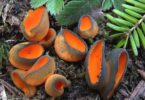

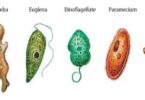
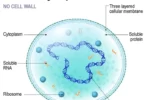
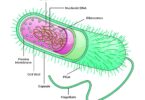
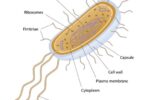
Leave a Comment